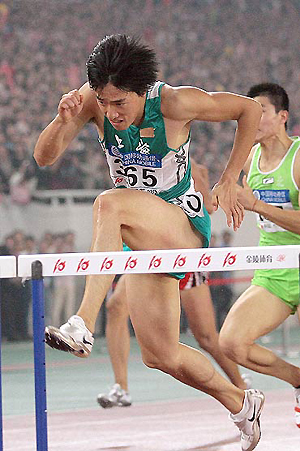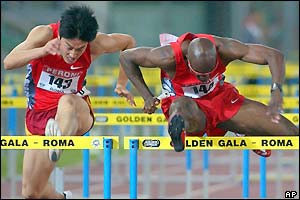While there is really no such thing as a quick fix to a technical problem in the hurdles, I have often found that the solution to a correcting a flaw ends up coming in the form of a very minor adjustment. Many times I have found myself amazed at how a minor adjustment can provide a major benefit in improving technique. Of course, these minor adjustments only prove useful if the hurdler is doing a lot of other things efficiently. Also, the quick fixes take a while to internalize, as do all adjustments in technique. So it’ll take a while before any adjustment successfully shows up in a race. Still, I’m always obsessively searching for simple solutions to difficult problems. The simpler I can keep my solutions, the easier it will be to communicate them to my athletes.
A few weeks ago, I was working with one of my hurdlers who was in the habit of swinging his lead arm across his body. It was the only obvious flaw in his technique. I’ll call him Hurdler1. Meanwhile, I had another hurdler who had an extremely efficient lead arm that never seemed to alter from its normal sprinting motion. I’ll call him Hurdler2. So, I was asking myself, What does Hurdler2 do differently from Hurdler1 that makes his lead arm so fluid and efficient?
I couldn’t figure it out. Just watching them hurdle in practice, I could see the difference, but still couldn’t identify the cause of it. So one day before practice, I got to the track early and set up two hurdles myself, and started doing lead leg drills over them. I thought to myself, if Hurdler2’s lead arm doesn’t alter from its normal sprinting motion, that means he must be keeping his thumb pointing up the whole time. Thinking back to past races and workouts, I acknowledged that, yeah, Hurdler2 does keep the thumb of his lead arm pointing up throughout hurdle clearance. Let me try that, I said to myself.
It worked. I felt my lead leg drop a lot quicker, and the trail leg still had all the room it needed to drive up underneath the armpit. Also, because the thumb was pointing up, the lead arm could not go across the body because that would be just too awkward and difficult of a motion. Then I did a rep allowing my thumb to point across my body, and sure enough, my arm went across my body. I did a few more reps both ways and came away convinced that “thumbs up” made all the difference in the world.


In these two photos, Liu Xiang of China demonstrates the “thumbs up” lead arm that enables him to hurdle with his
elbows close to his body, making for quick snapdown and a tight, efficient trail leg.
When practice started a few minutes later, I approached Hurdler1 with a gleam in my eyes and declared, “I’ve figured it out! Your lead arm – it’s all about the thumb, son, it’s all about the thumb.” I had him do some lead-leg drills focusing on the positioning of the thumb, and was amazed to see that the problem was solved! His lead arm was moving straight up-and-down, not angling across the body at all. Even between the hurdles, his sprinting mechanics were more efficient. With the thumb pointing up, the elbow of the lead arm wasn’t flaring out, but staying closer to the body. He too had a gleam in his eyes now that he saw the little trick was working.
He did a few reps over the top of the hurdle, with the same results. Still, in the next meet that weekend, you’d never know we had worked on the problem at all. Once the gun went off, he reverted back to his old habit of swinging the arm across his body. I say that to emphasize once again that there is no such thing as a quick fix. Everything in hurdling takes time. In practice, Hurdler1’s technique looks as mechanically precise as Hurdler2’s. But Hurdler2’s technique also looks that way in races, at hyper speeds, because he’s been doing it longer, been practicing it longer, so it is more ingrained in his muscle memory.
As coaches, we can never be content that our hurdlers’ technique is as good as it’s gonna get. There’s always something that can be improved. Finding solutions to technical problems is not just a matter of reading and studying film, but it’s also (and even more so, in my opinion), a matter of trusting your instincts, taking risks, approaching practice sessions with a sense of adventure, and being creative in the moment.
© 2006 Steve McGill
